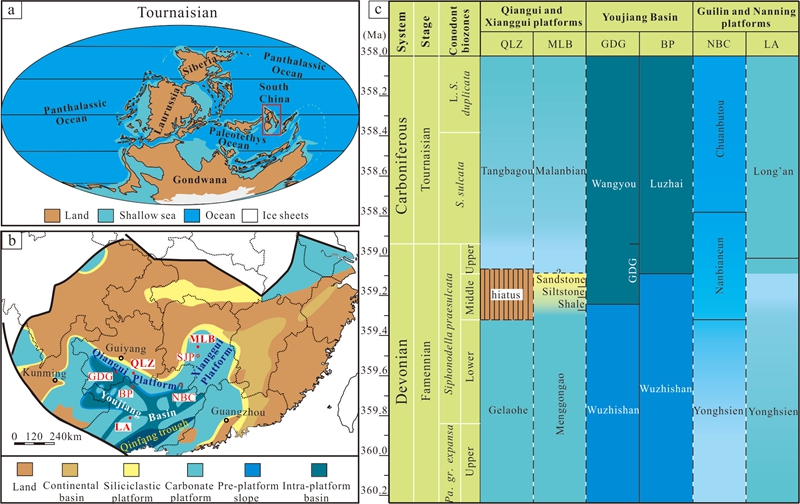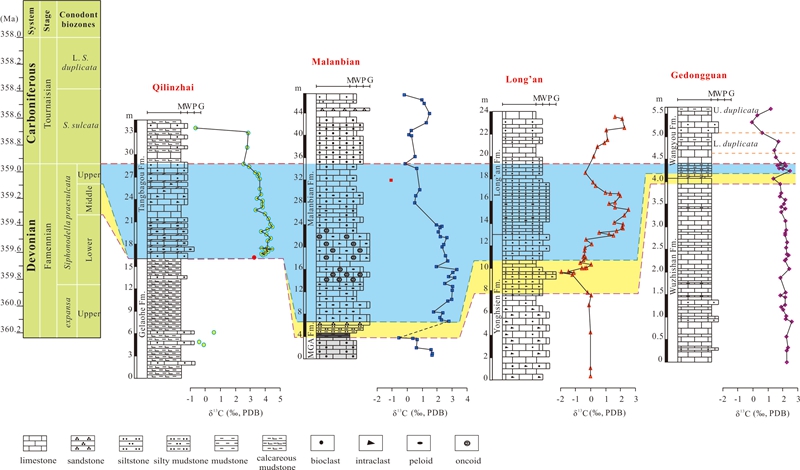The Devonian-Carboniferous transition was a period of major biotic and paleoenvironmental change characterized by one of the biggest Phanerozoic mass extinction events, the Hangenberg mass extinction. This event eliminated all the Paleozoic stromatoporoids from the ocean, leading to the demise of metazoan reef and changes of marine community. It was also accompanied by a distinct perturbation to the global carbon cycle recorded by positive excursions in δ13Ccarb and δ13Corg.
To better understand paleoenvironmental changes and controls on δ13Ccarb variation during this critical interval, an integrated study of the litho-, bio-, and chemostratigraphy of the Devonian-Carboniferous boundary at four sections (Qilinzhai, Malanbian, Gedongguan and Long’an) in South China was undertaken by Dr. QIE Wenkun and his colleagues from Nanjing Institute of Geology and Palaeontology, Chinese Academy of Sciences. Sedimentological data record a major regression in the Middle Siphonodella praesulcata Zone, which coincided with the Hangenberg Extinction (HE) in South China. Their new δ13Ccarb data document a negative δ13Ccarb shift near the base of the Middle Si. praesulcata zone, which may have been related to the HE. Prior to and during the HE, respiration of organic matter contributed abundant 12C-enriched dissolved inorganic carbon (DIC) to the restricted Nanning carbonate platform, resulting in a negative vertical δ13CDIC gradient in the study area. In the Upper Si.praesulcata Zone, all four sections exhibit a positive δ13Ccarb shift, suggesting that a vigorous biological pump existed in the aftermath of the latest Devonian glaciation. However, peak δ13Ccarb values differ markedly among the study sections, suggesting that local carbon cycling processes (e.g. input of terrestrial organic matters and nutrients, remineralization of organic matters) played an important role during the initial post-glacial transgression.
The paper was published in Palaeogeography, Palaeoclimatology, Palaeoecology, and financially supported by the National Natural Science Foundation of China.
Reference: Qie, W.K., Liu, J.S., Chen, J.T., Wang, X.D., Mii, H.S., Zhang, X.H., Huang, X., Yao, L., Algeo, T.J., Luo, G.M., 2015, Local overprints on the global carbonate δ13C signal in Devonian-Carboniferous boundary successions of South China. Palaeogeography, Palaeoclimatology, Palaeoecology 418, 290-303.

(a) Early Tournaisian global paleogeographic reconstruction (base map courtesy of Ron Blakey, http://jan.ucc.nau.edu/~rcb7/). (b) Early Tournaisian paleogeographic map of South China craton showing study section localities. (c) Generalized stratigraphy of the Devonian–Carboniferous succession in South China

Correlation of the δ13Ccarb profiles of the four study sections in South China
